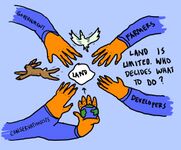LED2LEAP 2020 - Freising Team 1
Jump to navigation
Jump to search
>>>back to working groups overview
Landscape Democracy Rationale
- The community context is relevant because the landscape is function of how the community sees the landscape. As we understand how the community interprets the landscape we can build a better landscape that works for them. As our community grows we want to ensure the health and wellness of both the humans and the natural landscape.
- How does the landscape work for the benefit of human health and wellness? How can we bring community together to provide a healthy and happy life? That is the hypothesis considering the landscape democracy challenges.
Location and scope
- The overall location is the space between the two points, the Munich Airport and Dachau.
- Our main focus area is the Airport region south of Freising. Notice the large yellow areas around the airport, that is farmland and pasture. Also notice the water bodies surrounding the airport, they play an important part to the health of the area.
Phase A: Mapping your Community
Welcome to your community and its landscape
- The west side of the Munich Airport.
- Industural, agricultural, and nature land types.
- Freising is a young comunity.
- Issues with urban spraul, and maintaining a productive agricultural economy while allowing a positive life for humans and nature.
- Yourcase communityintro 2.jpg
add a caption
Groups of actors and stakeholders in your community
- Key Actors (Local Residents, Municipalities, Government, Landowners)
- Primary Actors (University, Schools, Students, Elderly, Families, Farmers, Airport Administration, Airport Employees, Unions, Munich commuters) These actors are concerned with their own health and those around them
- Secondary Actors (Small businesses, Tourists, Community Centers, Beer production, Religious Centers)
- The most visible actors are the landowners, the University and the Airport. All others are less visible.
- What we don't know is the direct thoughts of the citizens, we are working off assumptions based on reading and research.
Relationships between your actors and groups
- The power relationship is complicated but overall the large groups have more power than the smaller actors.
- Which groups may have shared interests and which are these? Many groups have shared interests. The land is a shared interest for a lot of groups. (max 200 signs)
- Food production brings together the landowners, farmers, business owners and government regulators.
- Many groups have a shared interest in the Airport and its functions. The workers, administrators, tourists, and people in the transportation sector have a lot of stake in the airport.
- Diagram Freising Group 1 1.jpg
A web of actors and groups connection
Summary of your learnings from the transnational discussion panel on April 22
On April 22 you will present the PPT version of this first assignment to other seminar groups working in other geographical community contexts. Please give here a short summary of your learnings during this presentation, for example:
- Other analytical approaches
- Other representation styles
- Other value schemes: any surprises?
- Constructive comments we received on our presentation
Theory reflection
- From the article The Just City Essays - 26 Visions for Urban Equity, Inclusion and Opportunity I got a better perspective on what is important for community inclusion. Being a good member of a community means having the goal of justice at the forefront of design. I want to think about how the design will positively or negatively influence the different members of the community and make changes from that.
- The article Pledge for a Transformative Science - A conceptual framework showed me the future thought process in how we use the scientific method. It reminded me a lot of the iterative process of having a problem, working to find a solution and then building off what you learned to continuously improve that was talked about in the lecture. I also like the holistic approach the article took about science.
- In The Right to Landscape: An Introduction, in: The Right to Landscape: Contesting Landscape and Human Rights, we learned how the right to landscape is a human rights issue. Landscape can provide many things, health and physical well being, mental well being, and economic well being. We need to focus on how we can up lift communities without landscape and create an environment that everyone can thrive in.
References
- The Just City Essays - 26 Visions for Urban Equity, Inclusion and Opportunity [1]
- Alejandro Aravena: My architectural philosophy? Bring the community into the process [2]
- Higher Education System in Germany [3]
- EVG [4]
- GEW [5]
- IGBAU [6]
- Pledge for a Transformative Science - A conceptual framework [7]
Phase B: Democratic Landscape Analysis and Assessment
* template coming
Phase C: Collaborative Visioning and Goal Setting
* template coming
Phase D: Collaborative Design, Transformation and Planning
* template coming
Phase E: Collaborative Design, Transformation and Planning
* template coming
= Phase E: Collaborative Evaluation and Future Agendas * template coming
Process Reflection
- Reflect in your intercultural and interdisciplinary team on the outcomes of your study
- Which limitations were you facing?
- What have you learnt from each other?
- What would you do differently next time?
- You can also use diagrams/visuals
- 250 words text







